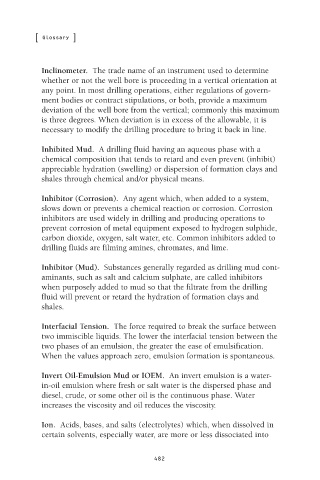Page 506 - Practical Well Planning and Drilling Manual
P. 506
Appendix NEW! revised 11/00/bc 1/30/01 3:30 PM Page 482
[ ]
Glossary
Inclinometer. The trade name of an instrument used to determine
whether or not the well bore is proceeding in a vertical orientation at
any point. In most drilling operations, either regulations of govern-
ment bodies or contract stipulations, or both, provide a maximum
deviation of the well bore from the vertical; commonly this maximum
is three degrees. When deviation is in excess of the allowable, it is
necessary to modify the drilling procedure to bring it back in line.
Inhibited Mud. A drilling fluid having an aqueous phase with a
chemical composition that tends to retard and even prevent (inhibit)
appreciable hydration (swelling) or dispersion of formation clays and
shales through chemical and/or physical means.
Inhibitor (Corrosion). Any agent which, when added to a system,
slows down or prevents a chemical reaction or corrosion. Corrosion
inhibitors are used widely in drilling and producing operations to
prevent corrosion of metal equipment exposed to hydrogen sulphide,
carbon dioxide, oxygen, salt water, etc. Common inhibitors added to
drilling fluids are filming amines, chromates, and lime.
Inhibitor (Mud). Substances generally regarded as drilling mud cont-
aminants, such as salt and calcium sulphate, are called inhibitors
when purposely added to mud so that the filtrate from the drilling
fluid will prevent or retard the hydration of formation clays and
shales.
Interfacial Tension. The force required to break the surface between
two immiscible liquids. The lower the interfacial tension between the
two phases of an emulsion, the greater the ease of emulsification.
When the values approach zero, emulsion formation is spontaneous.
Invert Oil-Emulsion Mud or IOEM. An invert emulsion is a water-
in-oil emulsion where fresh or salt water is the dispersed phase and
diesel, crude, or some other oil is the continuous phase. Water
increases the viscosity and oil reduces the viscosity.
Ion. Acids, bases, and salts (electrolytes) which, when dissolved in
certain solvents, especially water, are more or less dissociated into
482

